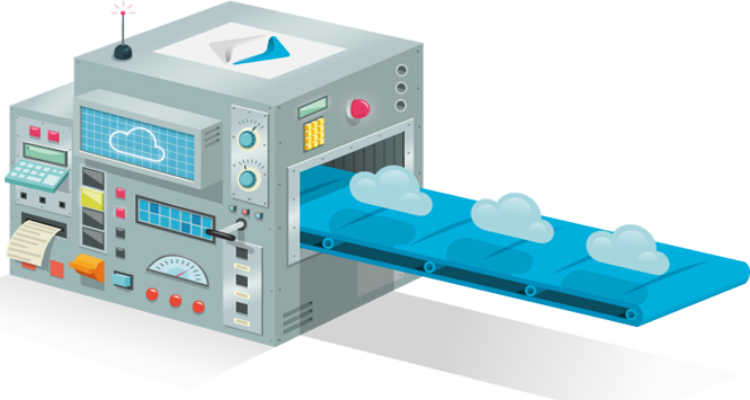Do not think about the minutes down
The wide distribution of cloud services has not bypassed such traditional service as “virtual private / dedicated server - VPS / VDS. A modern hosting solution is “Cloud VPS” (Cloud VPS) with a flexible resource management system and flexible payment scheme. The client pays only for using the service and according to the tariff set for a certain amount of resources. He independently determines and sets the amount of resources for his server that are currently required to solve his tasks. The user creates a server with the necessary characteristics and can change the resource consumption at any time, temporarily suspend the server, create a second server, etc.

Cloud hosting is virtual machines (VMs) in the cloud or IaaS (infrastructure as a service). With this hosting, physical servers are combined into a cluster, and storage systems into a storage area network (SAN). In aggregate, all this forms a pool of resources flexibly allocated to clients. Thus, with cloud hosting several servers are involved at once, the resources of which are evenly distributed over the load.
Cloud VPS hosting allows you to instantly scale or reduce resources - disk space, bandwidth, processor power, RAM in accordance with the IT requirements of your business.
')
The following table will help to understand the difference between the types of hosting:

Clients using cloud-based VPS have an opportunity to choose the type of payment - usually it is monthly, three-month, semi-annual and annual payment. But lately, more and more hosting providers are offering hourly and even per minute rates. It is worth noting that in the latter case we are talking about paying for computing resources, but not for storage resources. As an example, consider our new tariff with per minute payment, called “For resources”.
The “For Resources” tariff is advantageous, first of all, for those customers who acquire a virtual server to solve problems that require a single allocation of serious computing resources with significant server downtime without load. Savings are achieved due to the fact that the client pays only for the actual consumed resources in each specific minute of the working time of the virtual server.
The minimum payment that will be charged to the client is a one-time setup payment in the amount of 30 rubles, as well as full payment of the allocated disk space and IPv4 address according to the tariff.
So, the tariff "For resources" for 1 minute of use:
For example, consider the configuration:
According to the standard tariff RUVDS, a month of work with such a server costs 2 475 rubles. When working with this server at the “For Resources” tariff, the minimum payment will be 535.95 rubles per month, plus 30 rubles at a time for installation. The minimum payment consists of the payment for hard disk space and the IPv4 address (s) of the lease.
Thus, the client receives:
The ability to use only the necessary resources is an indisputable advantage of this technology. You can quickly change the characteristics of the virtual server (CPU, RAM, disk space) through our control panel. And per-minute billing allows you not to overpay for unused resources, making hosting cheaper. When you turn off a virtual machine in the control panel, funds are written off only for the leased disk space.

For example, you can create a cloud-based VPS, install the software on it, save it as a template, and quickly deploy if necessary, paying only the minutes of using the server each time. After all, resources are spent only if the cloud server is turned on. For shut down servers, RAM and processor resources are provided free of charge.
Per -minute cloud VPS tariffs are already offered by YourHost , NetPlace , 1loud , Lioo.ru , ForeverHost , HosterProf , Tvoi-host.ru , LX-host.net , EU-host.ru and some other hosting providers. Now they are joined by RUVDS.
Most hosting providers provide support for Linux, Windows operating systems, the ability to create entire clusters of servers, change the server configuration on the fly in many cases, even without rebooting.
The advantages of the RUVDS offer are low price in comparison with analogues on the Russian market, the presence of two data centers in Moscow and in Europe , so customers can choose the “location” of their VPS, the latest equipment from Huawei , used as a server platform. Finally, the cost of a Windows license is included in the price of the VPS server, and this is an additional savings.

Cloud hosting is virtual machines (VMs) in the cloud or IaaS (infrastructure as a service). With this hosting, physical servers are combined into a cluster, and storage systems into a storage area network (SAN). In aggregate, all this forms a pool of resources flexibly allocated to clients. Thus, with cloud hosting several servers are involved at once, the resources of which are evenly distributed over the load.
Cloud VPS hosting allows you to instantly scale or reduce resources - disk space, bandwidth, processor power, RAM in accordance with the IT requirements of your business.
')
The following table will help to understand the difference between the types of hosting:
| Model | Infrastructure | Scalability | What is best for | Pricing |
| VPS | A physical server used by a limited number of users. Common environment | Scaled "manually" by a request to the provider. | Sites with predictable traffic | The resources specified in the contract are paid monthly or annually. Required contracts. |
| Dedicated server | A physical server used by a single client / user. Isolated environment. | Not modernized. If the user needs to increase resources, you need to get another package, defined by the supplier, even if it is not optimal for your needs. | High-load web applications | The necessary resources are paid - monthly or annually. Required contracts. |
| Cloud server | Distributed resources on multiple physical servers. Isolated virtual environment. | Fast self-administration and deployment (a few clicks), scaling in a few seconds, zero downtime. | Wide range of tasks | Resources that are actually used are paid. Payment is usually hourly. No contracts required. |

Clients using cloud-based VPS have an opportunity to choose the type of payment - usually it is monthly, three-month, semi-annual and annual payment. But lately, more and more hosting providers are offering hourly and even per minute rates. It is worth noting that in the latter case we are talking about paying for computing resources, but not for storage resources. As an example, consider our new tariff with per minute payment, called “For resources”.
What is the “For Resources” tariff from RUVDS and how does it work?
The “For Resources” tariff is advantageous, first of all, for those customers who acquire a virtual server to solve problems that require a single allocation of serious computing resources with significant server downtime without load. Savings are achieved due to the fact that the client pays only for the actual consumed resources in each specific minute of the working time of the virtual server.
The minimum payment that will be charged to the client is a one-time setup payment in the amount of 30 rubles, as well as full payment of the allocated disk space and IPv4 address according to the tariff.
So, the tariff "For resources" for 1 minute of use:
| Type of resource / service | Price in rubles | Billing |
| Setup payment | thirty | one time |
| 1 MHz | 0,000008 | every minute |
| 1 MB RAM | 0,000006 | every minute |
| 1 MB read from disk | 0,002 | every minute |
| 1 MB recorded to disk | 0,003 | every minute |
| 1 MB, HDD | 0,00000007 | every minute |
| 1 MB, SSD | 0,00000025 | every minute |
| 1 IOPS | 0.001 | every minute |
| 1 MB of outgoing traffic | 0.001 | every minute |
| 1 MB of incoming traffic | 0.001 | every minute |
| 1 MB of outgoing DDOS traffic | 0.001 | every minute |
| 1 MB of incoming DDOS-protected traffic | 0,0035 | every minute |
| 1 IPv4 address | 0,0025 | every minute |
For example, consider the configuration:
- 10 2.2 GHz cores
- 10 GB RAM
- 50 GB HDD
- 1 IPv4 address
According to the standard tariff RUVDS, a month of work with such a server costs 2 475 rubles. When working with this server at the “For Resources” tariff, the minimum payment will be 535.95 rubles per month, plus 30 rubles at a time for installation. The minimum payment consists of the payment for hard disk space and the IPv4 address (s) of the lease.
Thus, the client receives:
- Powerful computing resource.
- Significant cost savings due to the charging of resources actually consumed every minute and the lack of payments for a simple server.
- Transparent billing.
- Easy and fast scalability - from the server to the computing cluster and back.
The ability to use only the necessary resources is an indisputable advantage of this technology. You can quickly change the characteristics of the virtual server (CPU, RAM, disk space) through our control panel. And per-minute billing allows you not to overpay for unused resources, making hosting cheaper. When you turn off a virtual machine in the control panel, funds are written off only for the leased disk space.

For example, you can create a cloud-based VPS, install the software on it, save it as a template, and quickly deploy if necessary, paying only the minutes of using the server each time. After all, resources are spent only if the cloud server is turned on. For shut down servers, RAM and processor resources are provided free of charge.
Per -minute cloud VPS tariffs are already offered by YourHost , NetPlace , 1loud , Lioo.ru , ForeverHost , HosterProf , Tvoi-host.ru , LX-host.net , EU-host.ru and some other hosting providers. Now they are joined by RUVDS.
Most hosting providers provide support for Linux, Windows operating systems, the ability to create entire clusters of servers, change the server configuration on the fly in many cases, even without rebooting.
The advantages of the RUVDS offer are low price in comparison with analogues on the Russian market, the presence of two data centers in Moscow and in Europe , so customers can choose the “location” of their VPS, the latest equipment from Huawei , used as a server platform. Finally, the cost of a Windows license is included in the price of the VPS server, and this is an additional savings.
Source: https://habr.com/ru/post/335350/
All Articles